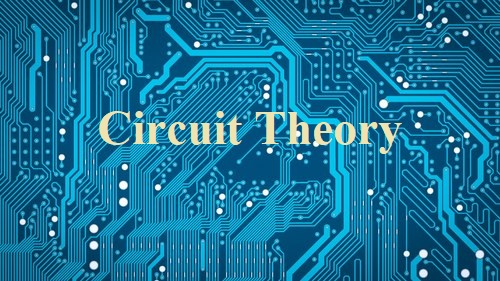PHY- 607 CIRCUIT THEORY Credit Hours: 4(3-1)
OBJECTIVE: To study the combinations of circuits, related laws and rules, different techniques of circuit analysis, network theorems, charge storing devices and make the students familiar with circuit maker software.
CONTENTS (1) Introduction: Resistance, temperature effect on resistance, thermistors, super conductors, types of resistors, varistor, strain gauge, resistor color code, ohms law, power, and energy, efficiency, home electricity billing system.
(2) Series and parallel circuits: series circuit, voltage sources in series, Kirchhoff‟s voltage law, voltage divider rule, voltage sources and ground, voltage regulation and the internal resistance of voltage sources, protoboards (breadboards), parallel circuit, Kirchhoff‟s current law, current divider rule, voltage sources in parallel, open and short circuits, series and parallel combinations, potentiometer loading
(3) Method of analysis: current sources, source conversions, current sources in parallel, current sources in series, branch-current analysis, mesh analysis (general approach), mesh analysis (format approach), nodal analysis (general approach), nodal analysis (format approach), bridge networks, y- delta and delta –y conversions,
(4) Network theorem: Superposition theorem, Thévenin‟s theorem, Norto‟s theorem, maximum power transfer theorem, Millman‟s theorem, substitution theorem, reciprocity theorem
(5) Capacitors: Capacitance, capacitor construction, internal structure and capacitance analysis, types of capacitors, temperature effects, capacitor labeling, transients in capacitive networks (the charging phase, discharging phase), instantaneous values, capacitors in series and in parallel, energy stored by a capacitor
(6) Inductors: Magnetic field, electromagnets and their applications, inductance, inductor construction, induced voltage, RL transients, reluctance, ohm‟s law for magnetic circuits, magnetizing force, Ampère‟s circuital law, RLC series and parallel circuits.
Practical: 1. Prove of Kirchhoff voltage law using Series circuits.
2. Prove of Kirchhoff current law using parallel circuits.
3. Determine the charge discharge effect of capacitor.
4. Determine instantaneous values, capacitors in series and in parallel
5. Study of RL/ RLC circuits
6. Prove of Thevenin Theorem
7. Norton Theorem
8. Maximum Power transfer theorem
SOFTWARE: Analysis of circuits in all chapters using multisim or circuit maker software BOOKS RECOMMENDED
1. Robert L. Boylestad. Introductory Circuit Analysis, 11th /e,
2. Hayt & Kimberly Circuit Analysis - Electrical and Computer Engineering, McGraw-Hill Book Company 8th /e

- Teacher: Ajab Kasi